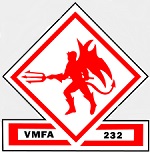Hobby Master HA3588 USMC Boeing F/A-18C Hornet Strike Fighter - 165222, VMFA-232, "Red Devils", November 2014 (1:72 Scale)
"Bigger, Higher, Faster, Farther."
- Thinking within the US Air Force during the late 1970s
 The F/A-18 Hornet is the true multi-role aircraft. It can vault from a carrier deck, bomb a target and stay to dogfight even the best enemy aircraft without missing a beat. It's the Navy's first modern-era jet intended for double duty against air- and ground-based adversaries. Armed to the hilt with Sparrow and Sidewinder air-to-air missiles, an internal cannon, and laser-guided bombs, this modern warbird was an outstanding performer in Operation Desert Storm. Strapped into a digital cockpit described as a cross between Star Wars and a video game, pilots of the F/A-18 Hornet take on the ultimate aviation job: blasting this single-seat, high-performance jet off the deck of a carrier, dropping bombs, and firing air-to-ground ordnance. Offering unmatched agility, the Hornet is the choice aircraft of the US Navy's elite Blue Angels aerobatic team.
The F/A-18 Hornet is the true multi-role aircraft. It can vault from a carrier deck, bomb a target and stay to dogfight even the best enemy aircraft without missing a beat. It's the Navy's first modern-era jet intended for double duty against air- and ground-based adversaries. Armed to the hilt with Sparrow and Sidewinder air-to-air missiles, an internal cannon, and laser-guided bombs, this modern warbird was an outstanding performer in Operation Desert Storm. Strapped into a digital cockpit described as a cross between Star Wars and a video game, pilots of the F/A-18 Hornet take on the ultimate aviation job: blasting this single-seat, high-performance jet off the deck of a carrier, dropping bombs, and firing air-to-ground ordnance. Offering unmatched agility, the Hornet is the choice aircraft of the US Navy's elite Blue Angels aerobatic team.
The F/A-18C is the single-seat variant and the F/A-18D is the two-seat variant. The D-model can be configured for training or as an all-weather strike craft. The "missionized" D model's rear seat is configured for a Marine Corps Naval Flight Officer who functions as a Weapons and Sensors Officer to assist in operating the weapons systems. The F/A-18D is primarily operated by the U.S. Marine Corps in the night attack and Forward Air Controller (Airborne) (FAC(A)) roles.
The F/A-18C and D models are the result of a block upgrade in 1987 incorporating upgraded radar, avionics, and the capacity to carry new missiles such as the AIM-120 AMRAAM air-to-air missile and AGM-65 Maverick and AGM-84 Harpoon air-to-surface missiles. Other upgrades include the Martin-Baker NACES (Navy Aircrew Common ejection seat), and a self-protection jammer. A synthetic aperture ground mapping radar enables the pilot to locate targets in poor visibility conditions. C and D models delivered since 1989 also have improved night attack abilities, consisting of the Hughes AN/AAR-50 thermal navigation pod, the Loral AN/AAS-38 NITE Hawk FLIR (forward looking infrared array) targeting pod, night vision goggles, and two full-color (formerly monochrome) multi-function display (MFDs) and a color moving map.
Pictured here is a gorgeous 1:72 scale diecast replica of a USMC Boeing F/A-18C Hornet strike fighter that was attached to VMFA-232, "Red Devils", during November 2014.
Pre-order! Ship Date: August 2025.
Dimensions:
Wingspan: 7-1/2-inches
Length: 9-inches
Release Date: ?
 Historical Account: "Red Devils" - Marine Fighter Attack Squadron 232 (VMFA-232) is a United States Marine Corps F/A-18 Hornet squadron. Nicknamed the "Red Devils", the squadron is based at Marine Corps Air Station Miramar, California and fall under the command of Marine Aircraft Group 11 (MAG-11) and the 3rd Marine Aircraft Wing (3rd MAW). The Red Devils are one of the oldest and most decorated fighter squadrons in the Marine Corps.
Historical Account: "Red Devils" - Marine Fighter Attack Squadron 232 (VMFA-232) is a United States Marine Corps F/A-18 Hornet squadron. Nicknamed the "Red Devils", the squadron is based at Marine Corps Air Station Miramar, California and fall under the command of Marine Aircraft Group 11 (MAG-11) and the 3rd Marine Aircraft Wing (3rd MAW). The Red Devils are one of the oldest and most decorated fighter squadrons in the Marine Corps.
The squadron deployed to Kuwait in January 2003 and took part in the 2003 invasion of Iraq as part of Operation Iraqi Freedom. During the three and a half weeks of the war the squadron flew 1,150 hours during 540 sorties dropping 620,000 pounds of ordnance. The squadron returned to MCAS Miramar in April 2003. In 2005, VMFA-232 became part of the United States Navy's Carrier Air Wing 11. In May 2005, they deployed with the rest of CVW-11 aboard the USS Nimitz to the Western Pacific and Persian Gulf, participating in combat operations in support of Operation Iraqi Freedom, Operation Enduring Freedom, and multinational exercises with Japan, Egypt, and India until November 2005. Early in the Nimitz deployment, several of the squadron members were interviewed for the PBS documentary Carrier. In 2007, the squadron deployed on the Nimitz again for a six-month cruise to the Persian Gulf. Four months later they did another WestPac deployment on the Nimitz. In January 2010 VMFA-232 accepted two F/A-18D Hornet aircraft and left in May 2010 for a deployment to Kandahar, Afghanistan in support of Operation Enduring Freedom. While in Afghanistan the Red Devils flew 4,090 Flight hours encompassing 1190 sorties and dropped 240,000 lbs of ordnance and expended 30,000 rounds of 20mm ammunition. They returned to MCAS Miramar in November 2010.


